Mary Anne Yarde's Blog: The Coffee Pot Book Club , page 91
May 4, 2020
Historical Fiction author, Vivienne Brereton, is taking a look at the extraordinary Field of Cloth of Gold. There is also a chance to check out Vivienne's fabulous book — A Phoenix Rising #Tudors @VivienneBreret1
Come and party like it’s 1520!At the extraordinary Field of Cloth of Gold.By Vivienne Brereton
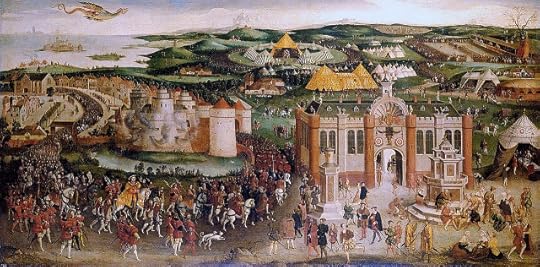 The Field of the Cloth of Gold, oil painting of circa 1545 in the Royal Collection at Hampton Court. Henry VIII on horseback approaches at bottom left. Wikipedia.
The Field of the Cloth of Gold, oil painting of circa 1545 in the Royal Collection at Hampton Court. Henry VIII on horseback approaches at bottom left. Wikipedia.
How could I have known back in November, 2019, when I came up with this invitation to attract potential readers to my novel that not many months later I wouldn’t be able to party myself. Indeed, none of us would. Fact is often stranger than fiction! In the sixteenth century, periodic periods of sickness/plague were very normal and royalty spent quite a lot of time fleeing from one safe house/castle to another. Using social distancing to remove themselves from anyone remotely contagious. Now, in 2020, the nearest any of us can get to the five hundredth anniversary celebrations of The Field of Cloth of Gold near Calais, France, is online in virtual tributes being organized by various groups. And the nearest to anything resembling a masque is the one on our face.
My own first encounter with the legendary Field, as far as I know, was on the cover of an ‘A’ level history book by Sir Geoffrey Elton (uncle of the comedian, Ben, considered the Sir David Starkey of his day) ‘England under the Tudors’. On the front cover of the book, first published in 1955 but periodically updated, is a colourful close-up of Henry VIII on his horse, wearing a doublet of bright red, shot through with exorbitantly expensive cloth of gold. He is surrounded by an army of noble followers, arriving at Calais in search of entertainment and pleasure - not in pursuit of war as in 1513. On the back cover of the book is a fountain spouting wine; the temporary English castle; the impromptu wrestling match between the Tudor King and the Valois King; and the magnificent tents of cloth of gold, or green and white striped ones: Tudor colours. That image must have buried itself deep into my subconscious because many years later, I found myself beginning a series of Tudor novels with the Field of Cloth of Gold as a rather splendid backdrop. ‘The House of the Red Duke’ is the result of extensive research and a very welcome reacquaintance with the
mesmerizing Field of Gold.
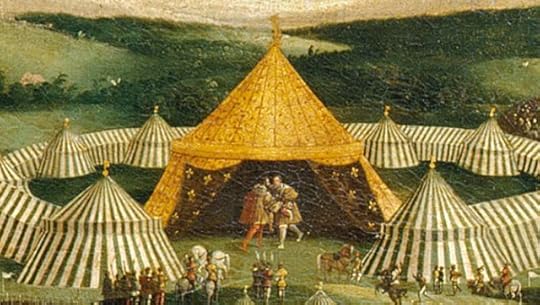
* * *
Dr. Joycelyne Gledhill Russell wrote the definitive account of the twentieth century in her 1969 ‘The Field of Cloth of Gold’, not to be updated for forty years until Professor Glen Richardson published his excellent book of the same name in 2013, described by Suzannah Lipscomb as “a sparkling new account.” Dr Russell describes the historic meeting as:
“an Olympic games: the jousts, tournaments, archery, wrestling. It was a musical and dramatic festival: the solemn music of royal choirs, the evenings’ minstrelsy, the masques. It was an architectural competition; the English raised a large temporary palace, the French a myriad tents and pavilions. It was a wine and food festival: the banquets, with every luxury in food and drink, and free wine for all. It was an international ‘concours d’elégance’ in dress and costume, in jewellery, and in caparisons for the choicest mounts.” It is generally agreed that the magnificent festival held just outside the English Pale of Calais, and the village of Ardres, in Picardy, France, was the brainchild of Thomas Wolsey, hot on the heels of his breathtakingly bold Treaty of London in 1518. Commissioned by both kings to arrange the festival, Henry VIII agreed to take six thousand of his subjects across what was then called the Narrow Sea to meet an equal number of the rival court of the French King, François I. In 1520, the political future of Europe was resting on the shoulders of the relatively inexperienced shoulders of three warlike young men: Charles of Habsburg, the twenty-year-old newly-elected Holy Roman Emperor; François of Valois, the twenty-five-year-old King of France; and Henry Tudor, at twenty-nine, the most senior of the three. The House of Tudor had been drawn into an enormous power struggle between the Houses of Habsburg and Valois so it is no surprise that the Festival was sandwiched in between a visit to England by Charles V and a second meeting between him and Henry straight after the end of the festivities. In the ever-shifting sands of European diplomacy, England was currently being courted by both French and Imperial representatives. In the centre of all this, stood Thomas Wolsey, relishing every moment of the courtship with as much delight as a desirable woman who has two suitors vying for her hand.
* * *
So, who was allowed to partake in this nod to our modern Olympic Games, Oscars, and Cannes Film Festival? Not the poor, that was for sure. Attracted by the idea of free food and wine, and the chance to see the rich and famous at play, François I issued a proclamation from Montreuil forbidding them to come within four leagues of his retinue, on pain of hanging. Having said that, the English chronicler, Edward Hall, makes reference to how: “vagabonds, ploughmen, labourers, waggoners, and beggars lay in drunken heaps” near two fountains: one of blue and gold and crowned with a statue of Bacchus, the god of wine; the other crowned with a statue of Cupid. It seems limitless quantities of red and white claret were dispensed to an eager crowd.
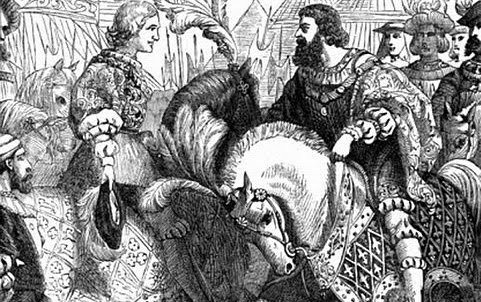
Proper invitations to the summit were as valuable and rare as one of Willy Wonka’s golden tickets but they came at a very high price. It was not unheard of for some people to mortgage off their estates to pay for their clothes; in fact, many were so eager to attend, they were prepared to carry their mills, forests and meadows on their backs. So was it all worth it? It seems so. There were some very dramatic moments such as the first meeting between the two Kings on Thursday, June 7th, the Feast of Corpus Christi. For obvious reasons, suspicion was paramount on both sides, both fearing the meeting could be a flimsy excuse for an ambush. Professor Richardson describes what happened: “The music of trumpets, sackbuts, flutes and drums, which had accompanied the marches to this point, was stilled. A tense silence reigned, broken only, it is pleasant to imagine, by the whinnying of horses and the twittering of swifts in the late-afternoon sky above. After a short time Francis moved his horse a few steps forward…The trumpets and sackbuts sounded again. The two kings detached themselves from their attendants and now faced each other alone with only a short distance between them…they spurred their horses forward. To the orchestrated cheers of their respective sides, each man reached for his bonnet and doffed it to the other in salute.”
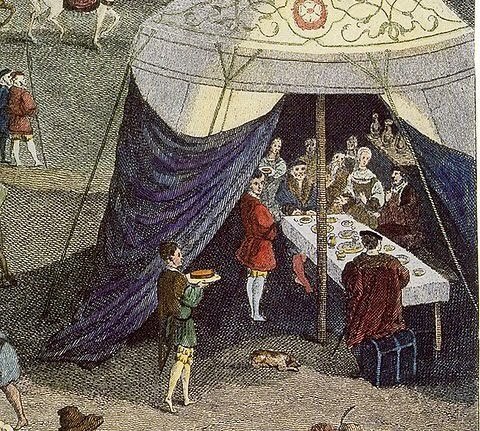
This gives an idea of the excitement and trepidation, both very real. The two kings finally met, dismounted and embraced before going into a tent for talks. Another less successful meeting came at an impromptu wrestling match between the two of them. An over-confident Henry challenged François to a game and was dismayed to find himself instantly sprawled on his back, owing to a clever ‘tour de Bretagne’. He tried to insist on a rematch but was turned down. As Professor Robert Knecht put it so succinctly: “The English records are silent about this incident.”
* * *
There were thrills and spills too in the lists, with the competitors keeping the audience entertained, not least by their choice of costume. Beneath an enormous artificial Tree of Honour upon which hung the shields of the competitors, lances would be broken and points scored; horses compared and the most prized, from Naples or Mantua, for example, given as gifts. Costumes were decorated with puzzles to keep the crowd guessing; one day King Francois wore one of purple velvet with little books in white satin. This was meant to mean ‘libera me’ (‘deliver me’) This word play continued into the following days and ended up being a message to a would-be lover to deliver him from his bonds of love.
All this proved to be very thirsty work, not to mention giving the competitors the appetite of a horse. With 160 tuns of French and Gascon wine and 560 tuns of beer, 340 cows, 800 calves, 80 hogs, plenty of fish, to mention just a few items, it is doubtful that anyone went hungry. It is not difficult to imagine the preening and point scoring that went on between both countries and both sexes. King Henry’s beautiful younger sister, Mary, formerly Queen of France, was more than happy to take her place once again in the spotlight. Queen Katherine must have a moment of anguish when she looked at the swollen belly of her French counterpart, Queen Claude, who had no problem delivering male heirs to her charming but faithless husband.
And how did this unforgettable extravaganza end? Russell lets the acerbic tongue of the disapproving Bishop John Fisher have the last word. As he put it:
“All wordely pleasures vanysshethe away,
To day a man in golde, to morrow closyde in clay.”
Richardson is more upbeat about the positive effect of the Festival and disagrees with Russell who described it as: “in fact merely an excuse for a party on a grand scale.”
From the vantage point of a world in April 2020, to all intents and purposes closed down as a result of Coronavirus, Russell’s description sounds very appealing.
To finish, I’d like to include a very short excerpt from The House of the Red Duke. It is before the start of the Festival and Thomas Howard, head of the mighty Howards, is imagining what the English and French are saying behind the scenes:
“As I gazed at the Thames ahead, I considered how talk of the Festival was taking place not only on water but also on land; I recalled all the comments I’d heard:
“By Saint George! How can you possibly need a gown of cloth of gold, as well as all the others?”
“Will we find Frenchmen more charming than our own?”
“Who’ll break more lances…us or them?”
“Can their court really be that dissolute?”
Across the Narrow Sea, I knew there was equal anticipation and excitement. Being very familiar with the French court, it didn’t take a huge leap of imagination to imagine what was being said there:
“Dieu merci, they speak our tongue, not just their own heathen one!”
“I’ve heard the women kiss on the mouth when greeting guests.”
“Will their King be taller than ours?”
“Perhaps I’ll find a wife amongst the English—””
A Phoenix Rising(The House of the Red Duke, #1)By Vivienne Brereton
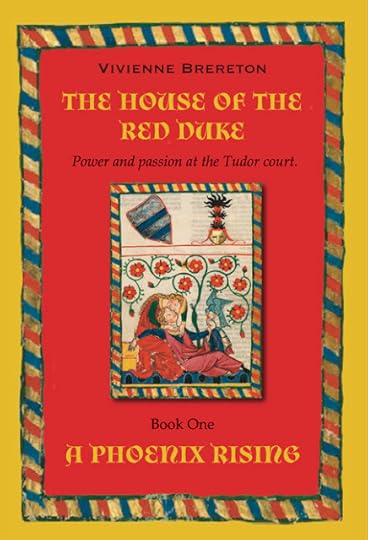
“If I have anything to do with it, we Howards will live forever.”
Thomas Howard Charismatic head of one of the most powerful Houses in Tudor England. An indomitable old man approaching eighty: soldier, courtier, politician, a ‘phoenix’ rising from the ashes. After a calamitous period of disgrace, the Howards, renowned for their good looks and charm, are once more riding high at the court of Henry VIII.
Set against the backdrop of the extraordinary 1520 ‘Field of Cloth of Gold’, it is a tale of ambition, love, and intrigue, with Thomas at the centre of this intricate tapestry
Will Thomas’s bold vow be fulfilled? Danger stalks the corridors of the royal courts of Europe. Uneasy lies the head beneath a crown. Every other ruler - a fickle bedfellow…or sworn enemy.
The action takes place in England, Scotland, and France. On either side of the Narrow Sea, four young lives are interwoven, partly unaware of each other, and certainly oblivious to what Dame Fortune has in store for them.
“Nicolas de La Barre laid his lute to one side, hardly bothering to stifle a yawn of boredom. Nevertheless, he couldn’t escape the fact he’d agreed to take on a new wife….”
Explosive family secrets are concealed behind the ancient walls of castles in three lands. But…
“There are no secrets that time does not reveal.”
Pick up your copy ofA Phoenix RisingAmazon UK • Amazon US
The Coffee Pot Book Club★★★★★ Highly RecommendedRead the full review HERE!
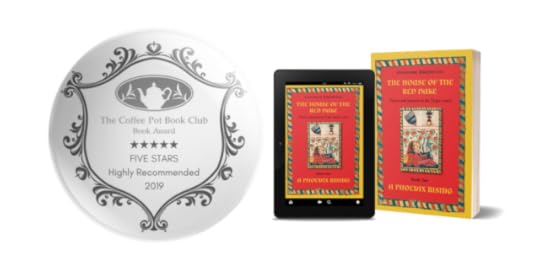
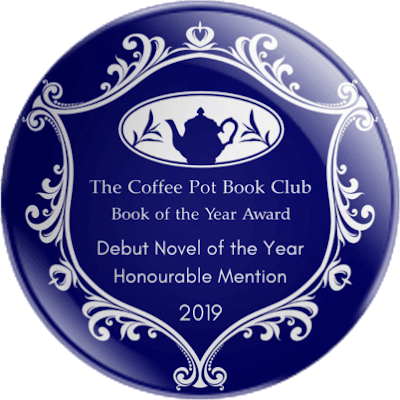
Vivienne Brereton
 I’ve always loved the Tudor period, from a very early age, have a degree in medieval history. I’ve lived in six different countries in my life and soaked up the history in each one. I now live in France which made writing about three different countries and cultures easier for me. I’ve always worked with words wherever I’ve lived: teaching, editing, writing.
I’ve always loved the Tudor period, from a very early age, have a degree in medieval history. I’ve lived in six different countries in my life and soaked up the history in each one. I now live in France which made writing about three different countries and cultures easier for me. I’ve always worked with words wherever I’ve lived: teaching, editing, writing.
I’m married with three sons so plenty of scope for Nicolas and Tristan! Anne Boleyn was the only character I found slightly elusive. All the others were so vivid, I had no problem getting into their heads. Of the kings, James was my favourite and after all my reading I hope I did him justice. All were brilliant men. Renaissance men, so cultured. What would they make of ours today? Harry could easily pass for Henry’s naughty little brother. Not sure Charles would make the grade.
Connect with Vivienne: Website • Blog • Goodreads.
 The Field of the Cloth of Gold, oil painting of circa 1545 in the Royal Collection at Hampton Court. Henry VIII on horseback approaches at bottom left. Wikipedia.
The Field of the Cloth of Gold, oil painting of circa 1545 in the Royal Collection at Hampton Court. Henry VIII on horseback approaches at bottom left. Wikipedia.How could I have known back in November, 2019, when I came up with this invitation to attract potential readers to my novel that not many months later I wouldn’t be able to party myself. Indeed, none of us would. Fact is often stranger than fiction! In the sixteenth century, periodic periods of sickness/plague were very normal and royalty spent quite a lot of time fleeing from one safe house/castle to another. Using social distancing to remove themselves from anyone remotely contagious. Now, in 2020, the nearest any of us can get to the five hundredth anniversary celebrations of The Field of Cloth of Gold near Calais, France, is online in virtual tributes being organized by various groups. And the nearest to anything resembling a masque is the one on our face.
My own first encounter with the legendary Field, as far as I know, was on the cover of an ‘A’ level history book by Sir Geoffrey Elton (uncle of the comedian, Ben, considered the Sir David Starkey of his day) ‘England under the Tudors’. On the front cover of the book, first published in 1955 but periodically updated, is a colourful close-up of Henry VIII on his horse, wearing a doublet of bright red, shot through with exorbitantly expensive cloth of gold. He is surrounded by an army of noble followers, arriving at Calais in search of entertainment and pleasure - not in pursuit of war as in 1513. On the back cover of the book is a fountain spouting wine; the temporary English castle; the impromptu wrestling match between the Tudor King and the Valois King; and the magnificent tents of cloth of gold, or green and white striped ones: Tudor colours. That image must have buried itself deep into my subconscious because many years later, I found myself beginning a series of Tudor novels with the Field of Cloth of Gold as a rather splendid backdrop. ‘The House of the Red Duke’ is the result of extensive research and a very welcome reacquaintance with the
mesmerizing Field of Gold.

* * *
Dr. Joycelyne Gledhill Russell wrote the definitive account of the twentieth century in her 1969 ‘The Field of Cloth of Gold’, not to be updated for forty years until Professor Glen Richardson published his excellent book of the same name in 2013, described by Suzannah Lipscomb as “a sparkling new account.” Dr Russell describes the historic meeting as:
“an Olympic games: the jousts, tournaments, archery, wrestling. It was a musical and dramatic festival: the solemn music of royal choirs, the evenings’ minstrelsy, the masques. It was an architectural competition; the English raised a large temporary palace, the French a myriad tents and pavilions. It was a wine and food festival: the banquets, with every luxury in food and drink, and free wine for all. It was an international ‘concours d’elégance’ in dress and costume, in jewellery, and in caparisons for the choicest mounts.” It is generally agreed that the magnificent festival held just outside the English Pale of Calais, and the village of Ardres, in Picardy, France, was the brainchild of Thomas Wolsey, hot on the heels of his breathtakingly bold Treaty of London in 1518. Commissioned by both kings to arrange the festival, Henry VIII agreed to take six thousand of his subjects across what was then called the Narrow Sea to meet an equal number of the rival court of the French King, François I. In 1520, the political future of Europe was resting on the shoulders of the relatively inexperienced shoulders of three warlike young men: Charles of Habsburg, the twenty-year-old newly-elected Holy Roman Emperor; François of Valois, the twenty-five-year-old King of France; and Henry Tudor, at twenty-nine, the most senior of the three. The House of Tudor had been drawn into an enormous power struggle between the Houses of Habsburg and Valois so it is no surprise that the Festival was sandwiched in between a visit to England by Charles V and a second meeting between him and Henry straight after the end of the festivities. In the ever-shifting sands of European diplomacy, England was currently being courted by both French and Imperial representatives. In the centre of all this, stood Thomas Wolsey, relishing every moment of the courtship with as much delight as a desirable woman who has two suitors vying for her hand.
* * *
So, who was allowed to partake in this nod to our modern Olympic Games, Oscars, and Cannes Film Festival? Not the poor, that was for sure. Attracted by the idea of free food and wine, and the chance to see the rich and famous at play, François I issued a proclamation from Montreuil forbidding them to come within four leagues of his retinue, on pain of hanging. Having said that, the English chronicler, Edward Hall, makes reference to how: “vagabonds, ploughmen, labourers, waggoners, and beggars lay in drunken heaps” near two fountains: one of blue and gold and crowned with a statue of Bacchus, the god of wine; the other crowned with a statue of Cupid. It seems limitless quantities of red and white claret were dispensed to an eager crowd.

Proper invitations to the summit were as valuable and rare as one of Willy Wonka’s golden tickets but they came at a very high price. It was not unheard of for some people to mortgage off their estates to pay for their clothes; in fact, many were so eager to attend, they were prepared to carry their mills, forests and meadows on their backs. So was it all worth it? It seems so. There were some very dramatic moments such as the first meeting between the two Kings on Thursday, June 7th, the Feast of Corpus Christi. For obvious reasons, suspicion was paramount on both sides, both fearing the meeting could be a flimsy excuse for an ambush. Professor Richardson describes what happened: “The music of trumpets, sackbuts, flutes and drums, which had accompanied the marches to this point, was stilled. A tense silence reigned, broken only, it is pleasant to imagine, by the whinnying of horses and the twittering of swifts in the late-afternoon sky above. After a short time Francis moved his horse a few steps forward…The trumpets and sackbuts sounded again. The two kings detached themselves from their attendants and now faced each other alone with only a short distance between them…they spurred their horses forward. To the orchestrated cheers of their respective sides, each man reached for his bonnet and doffed it to the other in salute.”

This gives an idea of the excitement and trepidation, both very real. The two kings finally met, dismounted and embraced before going into a tent for talks. Another less successful meeting came at an impromptu wrestling match between the two of them. An over-confident Henry challenged François to a game and was dismayed to find himself instantly sprawled on his back, owing to a clever ‘tour de Bretagne’. He tried to insist on a rematch but was turned down. As Professor Robert Knecht put it so succinctly: “The English records are silent about this incident.”
* * *
There were thrills and spills too in the lists, with the competitors keeping the audience entertained, not least by their choice of costume. Beneath an enormous artificial Tree of Honour upon which hung the shields of the competitors, lances would be broken and points scored; horses compared and the most prized, from Naples or Mantua, for example, given as gifts. Costumes were decorated with puzzles to keep the crowd guessing; one day King Francois wore one of purple velvet with little books in white satin. This was meant to mean ‘libera me’ (‘deliver me’) This word play continued into the following days and ended up being a message to a would-be lover to deliver him from his bonds of love.
All this proved to be very thirsty work, not to mention giving the competitors the appetite of a horse. With 160 tuns of French and Gascon wine and 560 tuns of beer, 340 cows, 800 calves, 80 hogs, plenty of fish, to mention just a few items, it is doubtful that anyone went hungry. It is not difficult to imagine the preening and point scoring that went on between both countries and both sexes. King Henry’s beautiful younger sister, Mary, formerly Queen of France, was more than happy to take her place once again in the spotlight. Queen Katherine must have a moment of anguish when she looked at the swollen belly of her French counterpart, Queen Claude, who had no problem delivering male heirs to her charming but faithless husband.
And how did this unforgettable extravaganza end? Russell lets the acerbic tongue of the disapproving Bishop John Fisher have the last word. As he put it:
“All wordely pleasures vanysshethe away,
To day a man in golde, to morrow closyde in clay.”
Richardson is more upbeat about the positive effect of the Festival and disagrees with Russell who described it as: “in fact merely an excuse for a party on a grand scale.”
From the vantage point of a world in April 2020, to all intents and purposes closed down as a result of Coronavirus, Russell’s description sounds very appealing.
To finish, I’d like to include a very short excerpt from The House of the Red Duke. It is before the start of the Festival and Thomas Howard, head of the mighty Howards, is imagining what the English and French are saying behind the scenes:
“As I gazed at the Thames ahead, I considered how talk of the Festival was taking place not only on water but also on land; I recalled all the comments I’d heard:
“By Saint George! How can you possibly need a gown of cloth of gold, as well as all the others?”
“Will we find Frenchmen more charming than our own?”
“Who’ll break more lances…us or them?”
“Can their court really be that dissolute?”
Across the Narrow Sea, I knew there was equal anticipation and excitement. Being very familiar with the French court, it didn’t take a huge leap of imagination to imagine what was being said there:
“Dieu merci, they speak our tongue, not just their own heathen one!”
“I’ve heard the women kiss on the mouth when greeting guests.”
“Will their King be taller than ours?”
“Perhaps I’ll find a wife amongst the English—””
A Phoenix Rising(The House of the Red Duke, #1)By Vivienne Brereton

“If I have anything to do with it, we Howards will live forever.”
Thomas Howard Charismatic head of one of the most powerful Houses in Tudor England. An indomitable old man approaching eighty: soldier, courtier, politician, a ‘phoenix’ rising from the ashes. After a calamitous period of disgrace, the Howards, renowned for their good looks and charm, are once more riding high at the court of Henry VIII.
Set against the backdrop of the extraordinary 1520 ‘Field of Cloth of Gold’, it is a tale of ambition, love, and intrigue, with Thomas at the centre of this intricate tapestry
Will Thomas’s bold vow be fulfilled? Danger stalks the corridors of the royal courts of Europe. Uneasy lies the head beneath a crown. Every other ruler - a fickle bedfellow…or sworn enemy.
The action takes place in England, Scotland, and France. On either side of the Narrow Sea, four young lives are interwoven, partly unaware of each other, and certainly oblivious to what Dame Fortune has in store for them.
“Nicolas de La Barre laid his lute to one side, hardly bothering to stifle a yawn of boredom. Nevertheless, he couldn’t escape the fact he’d agreed to take on a new wife….”
Explosive family secrets are concealed behind the ancient walls of castles in three lands. But…
“There are no secrets that time does not reveal.”
Pick up your copy ofA Phoenix RisingAmazon UK • Amazon US
The Coffee Pot Book Club★★★★★ Highly RecommendedRead the full review HERE!


Vivienne Brereton
 I’ve always loved the Tudor period, from a very early age, have a degree in medieval history. I’ve lived in six different countries in my life and soaked up the history in each one. I now live in France which made writing about three different countries and cultures easier for me. I’ve always worked with words wherever I’ve lived: teaching, editing, writing.
I’ve always loved the Tudor period, from a very early age, have a degree in medieval history. I’ve lived in six different countries in my life and soaked up the history in each one. I now live in France which made writing about three different countries and cultures easier for me. I’ve always worked with words wherever I’ve lived: teaching, editing, writing. I’m married with three sons so plenty of scope for Nicolas and Tristan! Anne Boleyn was the only character I found slightly elusive. All the others were so vivid, I had no problem getting into their heads. Of the kings, James was my favourite and after all my reading I hope I did him justice. All were brilliant men. Renaissance men, so cultured. What would they make of ours today? Harry could easily pass for Henry’s naughty little brother. Not sure Charles would make the grade.
Connect with Vivienne: Website • Blog • Goodreads.
Published on May 04, 2020 20:00
Become a Blog Tour Host with The Coffee Pot Book Club #BlogTours #HistoricalFiction #BookPromotion
Do you love Blogging and talking about Historical Fiction?

The Coffee Pot Book Club is looking for Historical Fiction bloggers just like you to become blog hosts for our tours.
If you like to read, review or simply talk about Historical Fiction on your blog, then why not become a blog host for The Coffee Pot Book Club?
Benefits:
· You will meet some fabulous authors and their books.· You will have a chance to read and review some wonderful books.· You will be part of a team of like-minded individuals (who all love Historical Fiction).· *If you are a Historical Fiction author and are also a Coffee Pot Tour Host, you will receive 20% of the prices of the Coffee Pot Tours.· You will receive a really cool Coffee Pot Tour Host badge to add to the sidebar of your blog.
If you are interested in becoming a tour host or would like more information, then please contact Mary Anne HERE!
* Terms and Conditions apply.

The Coffee Pot Book Club is looking for Historical Fiction bloggers just like you to become blog hosts for our tours.
If you like to read, review or simply talk about Historical Fiction on your blog, then why not become a blog host for The Coffee Pot Book Club?
Benefits:
· You will meet some fabulous authors and their books.· You will have a chance to read and review some wonderful books.· You will be part of a team of like-minded individuals (who all love Historical Fiction).· *If you are a Historical Fiction author and are also a Coffee Pot Tour Host, you will receive 20% of the prices of the Coffee Pot Tours.· You will receive a really cool Coffee Pot Tour Host badge to add to the sidebar of your blog.
If you are interested in becoming a tour host or would like more information, then please contact Mary Anne HERE!
* Terms and Conditions apply.
Published on May 04, 2020 09:12
May 3, 2020
#BookReview — A Child Lost: A Henrietta and Inspector Howard Novel, Book #5 by Michelle Cox #HistoricalFiction #HistoricalThriller @michellecox33
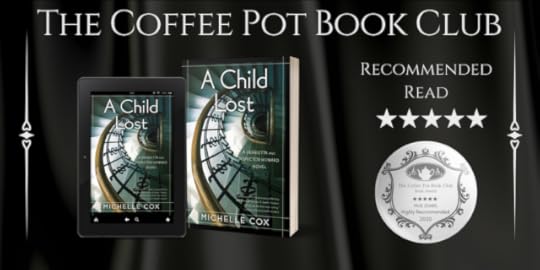
A Child LostA Henrietta and Inspector Howard Novel, Book #5By Michelle Cox
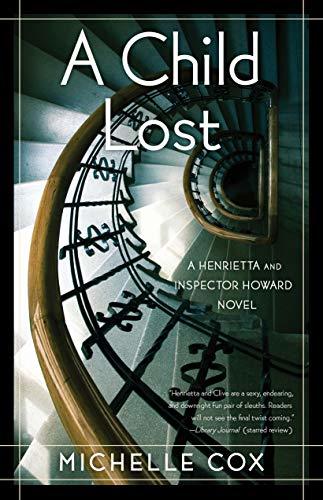
A spiritualist, an insane asylum, a lost little girl . . .
When Clive, anxious to distract a depressed Henrietta, begs Sergeant Frank Davis for a case, he is assigned to investigating a seemingly boring affair: a spiritualist woman operating in an abandoned schoolhouse on the edge of town who is suspected of robbing people of their valuables. What begins as an open and shut case becomes more complicated, however, when Henrietta—much to Clive’s dismay—begins to believe the spiritualist's strange ramblings.
Meanwhile, Elsie begs Clive and Henrietta to help her and the object of her budding love, Gunther, locate the whereabouts of one Liesel Klinkhammer, the German woman Gunther has traveled to America to find and the mother of the little girl, Anna, whom he has brought along with him. The search leads them to Dunning Asylum, where they discover some terrible truths about Liesel. When the child, Anna, is herself mistakenly admitted to the asylum after an epileptic fit, Clive and Henrietta return to Dunning to retrieve her. This time, however, Henrietta begins to suspect that something darker may be happening. When Clive doesn’t believe her, she decides to take matters into her own hands . . . with horrifying results.

"We need to find her, you see," Elsie rushed on. "This Liesel. So we, well, I thought that maybe you and Clive could help?" Elsie's voice was getting higher and more faint as she spoke. "You know, with the new detective agency…"
Gunther Stockel had gambled everything and lost. Now he was alone in Chicago with a child that wasn't his, looking for a woman who did not want to be found.
Elsie Von Harmon was seriously considering becoming a nun, that was until she met Gunther. She cannot help but want to assist Gunther in his search to find Liesel Klinkhammer and reunite her with her child. However, time is running out, for Gunther is no longer in a position where he can take care of his charge. He has to work, and Anna is not a well child. He fears as he did back in Germany, that one day someone would take her from him for good.
Elsie is loathed to ask, but who else can she turn to but her sister? If she could convince Henrietta and her husband Clive, who runs a detective agency, to take on the case then maybe they will succeed where Gunther has failed.
However, things take a sinister turn when Henrietta discovers what really happened to Liesel Klinkhammer…
From the despair of a man who is running out of time to the discovery of a dark and dangerous truth, A Child Lost: A Henrietta and Inspector Howard Novel Book #5 by Michelle Cox is in all ways a Historical Fiction triumph!
With an enthralling narrative that grabbed me from the opening paragraph and did not let go until that final full stop, A Child Lost: A Henrietta and Inspector Howard Novel Book #5, is a book that appeals, impresses, appals, and fascinates in almost equal measures. There is not one dull moment in this book. Cox has penned a novel that is as impressive as it is brilliant.
There are several noteworthy characters in this story, but the one I utterly adored was Henrietta. Henrietta is this wonderfully insightful young woman who burns with a desire to find out the truth for her clients. She is a very heroic heroine who is doing a man's job in a time when a woman's place was in the home. I have to confess, I have not read the rest of the books in this series, but I got the sense that Henrietta married above her social station and therefore she is not a social butterfly, although she will willingly act the part. Instead, Henrietta wants to help people, she wants to discover the truth, and this leads to some rather rash decisions which have disastrous consequences. Of course, it also leads to a fabulous story and one I could not tear myself away from. I thought Cox's depiction of Henrietta was sublime. I loved everything about her.
Another character that captured my attention was Elsie Von Harmon. Elsie has this tremendous capacity to love, and she really brings something amazing to this tale. I could not help but like her. I thought her depiction was simply marvellous.
This novel deals with some very uncomfortable issues. The patients at The Chicago State Hospital "Dunning" Mental Asylum are being denied the right of a safe and secure hospital where they can get the treatment that they not only need, but deserve. Cox describes, with a great deal of care to the historical detail, the plight of a hospital that is woefully understaffed and does not have the capacity to cater for such a large number of patients. The nurses and doctors that are there seemingly lack any empathy, and if they did at some point sympathise with their patients, then the relentlessness of the job has unfortunately quelled any compassion for these poor unfortunate people who end up under their care. The fact that children were housed with adults and given the same treatment was genuinely shocking. Cox also portrays the very fine line between eccentricity and madness. You were called eccentric only if you could afford it — otherwise, you were just insane. I thought Cox captured the fear, the dread, the utter despondence and misery that a mental asylum such as Dunning's would have evoked. This book is not always an easy read, and there are some very distressing scenes, but the overall effect paints a candid picture of what these hospitals were, unfortunately, like.
The power the staff have over the patience at Dunning mental asylum is absolute. The image of a hospital is one where someone goes for treatment in the hope to be cured, but Dunning is the kind of hospital where one is locked away and forgotten. It is a realm beyond hope. There is no golden city waiting to be found, despite what one of the patients might say. Here, the nurses rule the world as well as the ward, and while some are disguised as Angels of Mercy, others are Angels of Death — and sometimes it is very hard to decipher between the two. The lack of understanding of mental health and indeed, epilepsy, in this era is shameful. The fact that the era saw the mentally and neurologically unwell people as burdens, as something that should be hidden from society for fear that one could catch it, is shockingly awful. The treatments that were prescribed, and carried on being prescribed for decades is disgraceful. Cox also asks her readers to consider the difference between the staff at Dunning and the patients — who is the more insane? The one who does not remember their name, or the one who no longer feels compassion? It is a sobering thought.
Asides from mental health issues, Cox also explores the devastation and grief of a miscarriage and how no one is comfortable enough to talk about it and to grieve with the woman in question. The emotional toll and the lack of sympathy is, unfortunately, an all too familiar story even in today's society where miscarriage is still a taboo subject. Likewise, Cox explores the devastating impact of domestic abuse. Both of these topics Cox has approached with a novelist's eye for the human detail, which made these scenes all the more real in the telling.
The historical detail makes this book a monumental work of scholarship. Cox must have dedicated many hours to researching this era and, in particular, some of the places that her characters visit. Her research was undoubtedly worth the effort, for this book rings loudly with historical authenticity and grace. Kudos, Ms Cox. Kudos indeed.
As I have already stated, I have not read any of the other books in A Henrietta and Inspector Howard Novel series, but much to my delight I did not need to. Cox gives just enough background to the characters that it is no effort for a reader to catch up.
If you enjoy your Historical Fiction to have a thriller edge, then you are going to adore A Child Lost: A Henrietta and Inspector Howard Novel Book #5 by Michelle Cox.
I Highly Recommend.
Review by Mary Anne Yarde.The Coffee Pot Book Club.
Pick up your copy ofA Child LostAmazon UK • Amazon US
Michelle Cox
 Michelle Cox is the author of the multiple award-winning Henrietta and Inspector Howard series as well as Novel Notes of Local Lore, a weekly blog dedicated to Chicagos forgotten residents. She suspects she may have once lived in the 1930s and, having yet to discover a handy time machine lying around, has resorted to writing about the era as a way of getting herself back there.
Michelle Cox is the author of the multiple award-winning Henrietta and Inspector Howard series as well as Novel Notes of Local Lore, a weekly blog dedicated to Chicagos forgotten residents. She suspects she may have once lived in the 1930s and, having yet to discover a handy time machine lying around, has resorted to writing about the era as a way of getting herself back there.Coincidentally, her books have been praised by Kirkus, Library Journal, Publishers Weekly, Booklist and many others, so she might be on to something. Unbeknownst to most, Michelle hoards board games she doesn’t have time to play and is, not surprisingly, addicted to period dramas and big band music. Also marmalade.
Connect with Michelle: Website • Blog • Facebook • Twitter • Instagram • LinkedIn • BookBub.
Published on May 03, 2020 21:00
The smallest of the maids – life in the 17th centuryby Anna Belfrage @abelfrageauthor #mustread #ShortStory #Historical @abelfrageauthor
The smallest of the maids – life in the 17th centuryBy Anna Belfrage
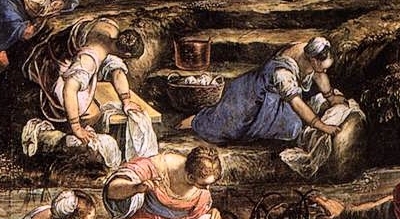
The moment the ice began breaking up, Mistress Euphemia started planning the over-due laundry day. Weeks of lingering winter had resulted in piles of soiled linen and to hear it, the household was reaching a stage where there would be no clean shirts for the master or mistress. Gentlefolk could not be expected to wear the same linen chemise for well over a month—or so Mistress Euphemia said, going on to explain that their lady had the most sensitive skin, a delicate flower that wilted under the abrasions of over-used sheets.In Ellen’s opinion there was nothing delicate about Lady Cecilia. Their young mistress was a fire-breathing dragon who had everyone in the household on their toes, including her ageing husband and Mistress Euphemia, the overweight housekeeper.
“What are you dreaming about?” Fat fingers pinched Ellen’s cheek.
“Nothing, mistress,” Ellen replied, dipping Mistress Euphemia a curtsey. She did not rub her aching cheek—to do so would just have the housekeeper pinch her again.
“Nothing?” The housekeeper snorted. “All you have in that head of yours are fripperies.” She pointed at the closest pile of linens. “Get to it, girl!”
“Yes, mistress.” Ellen filled her arms with dirty shirts and hastened over to the barrels lining the laundry shed. She held her breath as she got closer to avoid inhaling the acrid scent of old piss, hastily dunking her load into the closest of the barrels before rushing back for yet another armful.Old Sara was put in charge of preparing the lye for tomorrow. Ellen and Marie were ordered to ensure every single garment was soaking in urine before filling the huge cauldrons with water.
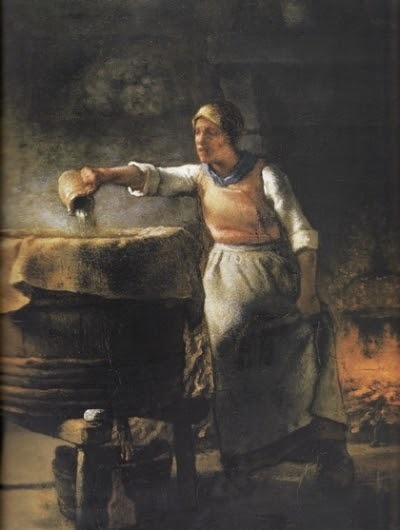
“Why can’t some of the men help with this?” Ellen muttered to Marie as they lugged bucket after bucket from the well to the laundry shed. She knew, of course: the manor was short on menfolk, and the few that were still around were either too old, too maimed or too important to carry water. An icy wind tugged at her shawl, the water she spilled on her skirts and apron stiffening into brittle ice. Her hands were red with cold and come tomorrow it would be even worse.Next day dawned bright—and crisp. Frost sparkled in the reeds closest to the lake’s shore, the dark water rimmed by glittering ice. In the laundry shed it was hot. Back and forth Ellen went, dumping sodden piss-drenched linen into a rinsing through where she poured bucket after bucket of water over them before carrying the heavy and wet garments to the cauldrons. Water hissed and spat, the lye stung her hands, and after less than an hour, her shoulders ached. She had to stand on a stool to reach, leaning into the steam as she stirred the laundry, dragging her stick round and round. The stool wobbled. For an instant, she feared she’d pitch headfirst into the water, but Sara grabbed hold of her and Ellen swallowed back a sob.
“I’ll do it,” Sara said. “You can carry instead.”
Ellen gave her a grateful smile and hastened over to where steaming, newly boiled garments and sheets were heaped into wicker baskets. Ellen was small. The baskets were heavy—so, so heavy—and the ground underfoot was slippery in places, small patches of ice causing her sturdy clogs to slide this way and that.By the lake, scrubbing boards were already waiting. Kneeling on the rough boards of the jetty, Ellen did as the others: one garment at a time was dipped into the lake, scrubbed, dunked again. Over and over, until all the lye had been rinsed out. The lye made Ellen’s skin itch. Her nails throbbed with the cold but she knew better than to complain: she was here on sufferance. Two bowls of barley gruel a day, bread, a strip of salted pork and warm spot in which to sleep—Ellen was fortunate, or so Mistress Euphemia would tell her. Ellen’s mother agreed: with six children to feed and a husband she’d not seen since he’d been hauled off to serve in Gustaf II Adolf’s army three years ago, Ellen’s mother had been relieved to send Ellen off to serve at the local manor, even if she was not yet ten.
“Be a good girl,” Mamma had said, tightening the knot on the little bundle that contained everything Ellen owned: a spare chemise and a white clout for Sunday wear.Ellen tried to be a good girl. She might be the smallest of the maids, but she worked hard, said little and avoided the few men on the manor.
“Not an able-bodied man left soon,” Mistress Euphemia had complained to the cook last week. “Off they go to win glory and gold in the king’s war. Pah! They return permanently maimed or not at all, and what gold there may be ends up in the pockets of the officers.”
Mistress Euphemia, Sara had confided, had seen both her sons ride off to join the king’s army. Neither of them had returned, and God alone knew if they were dead somewhere in Saxony or if they were still alive.“Daydreaming again?” A hard slap had Ellen biting back a whimper.
“No, Mistress,” she said, increasing her efforts on the scrubbing board.
“Useless child,” Mistress Euphemia said to her back. “Too small and puny to be of any real use. Why I ever offered you a place here I do not know.”
Ellen scrubbed even harder. Should she be sent home, Mamma would despair, because there was nothing to eat. Come sun and warmth there’d be nettles and birch sap, bird’s eggs and rabbits. But now, in the bleak months where winter still ruled, everyone went hungry, the winter stores long since run out.The sun was dipping towards the west when Ellen began on her final basket. Her hands were numb well up to her elbow and she’d been shivering for the last hour. When she grabbed a garment out of the basket her movements were clumsy and uncoordinated. A shirt. She dunked it into the water, trying to tighten her grip on the fabric. Her fingers didn’t work as they should. Like fat, swollen sausages, they would not bend. Her hold on the shirt slipped. It floated away.
“That’s the master’s best shirt!” Mistress Euphemia roared. “What have you done, you foolish, foolish child?”
Ellen barely registered the blows, but all of her quaked when Mistress Euphemia promised she’d be out on her ear for this. Immediately.
“I’ll just…” If she stretched, she might just reach the billowing sleeve.
“Ellen!” Mistress Euphemia barked, and now there was another note to her voice. “Child, no!”
Too late. Ellen fell face first into the icy waters. In front of her, the linen shirt floated just below the surface. The afternoon sun lit up the waters from above, and it was so very, very cold. Ellen tried to kick, tried to move her arms as Sven had taught her last summer in the lake back home. For an instant, her head broke the surface. She heard someone shout her name. Mamma?
“Mamma,” she cried, and her mouth filled with water.
The last thing she saw was Mistress Euphemia, one hand covering her mouth as tears ran down her cheeks. And then she sank into the icy embrace of the lake, her hand tangled round a fine linen shirt edged with lace.
Check out Anna's fabulous books!
The Graham SagaShe is dragged back through time to a new life, a new and frightening world. And a new man…
Love. Drama. Heartbreaking loss & heady adventure. Welcome to The Graham Saga!

The King's Greatest EnemyThe fourth book in my series The King’s Greatest Enemy, is here! Publication date Feb 16, 2017.Welcome to 14th century England, to the world of an inept king, a rebellious baron and an adulterous queen. Welcome to the life of Adam de Guirande, an honourable knight torn apart by his loyalties.
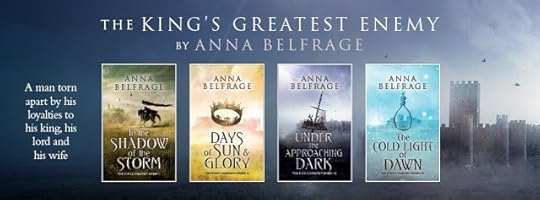
The WandererSay hello to Jason and HelleThis is a dark, edgy romance – and a rather steamy read. Helle has moments when she believes Jason is insane – but she has no doubt whatever that Jason is a far safer bet than dark and dangerous Sam Woolf. Definitely.

Anna Belfrage
 Had Anna been allowed to choose, she’d have become a time-traveller. As this was impossible, she became a financial professional with two absorbing interests: history and writing. Anna has authored the acclaimed time travelling series The Graham Saga, set in 17th century Scotland and Maryland, as well as the equally acclaimed medieval series The King’s Greatest Enemy which is set in 14th century England. She has recently released A Flame through Eternity, the third in a new series, The Wanderer, a fast-paced contemporary romantic suspense with paranormal and time-slip ingredients. At present, Anna is working on a new medieval series in which Edward I features prominently as well as a book set in 1715 where magic lockets and Jacobite rebels add quite the twist.
Had Anna been allowed to choose, she’d have become a time-traveller. As this was impossible, she became a financial professional with two absorbing interests: history and writing. Anna has authored the acclaimed time travelling series The Graham Saga, set in 17th century Scotland and Maryland, as well as the equally acclaimed medieval series The King’s Greatest Enemy which is set in 14th century England. She has recently released A Flame through Eternity, the third in a new series, The Wanderer, a fast-paced contemporary romantic suspense with paranormal and time-slip ingredients. At present, Anna is working on a new medieval series in which Edward I features prominently as well as a book set in 1715 where magic lockets and Jacobite rebels add quite the twist.
Find out more about Anna by visiting her website, www.annabelfrage.com or her Amazon page.You can also find her on Facebook or Twitter.

The moment the ice began breaking up, Mistress Euphemia started planning the over-due laundry day. Weeks of lingering winter had resulted in piles of soiled linen and to hear it, the household was reaching a stage where there would be no clean shirts for the master or mistress. Gentlefolk could not be expected to wear the same linen chemise for well over a month—or so Mistress Euphemia said, going on to explain that their lady had the most sensitive skin, a delicate flower that wilted under the abrasions of over-used sheets.In Ellen’s opinion there was nothing delicate about Lady Cecilia. Their young mistress was a fire-breathing dragon who had everyone in the household on their toes, including her ageing husband and Mistress Euphemia, the overweight housekeeper.
“What are you dreaming about?” Fat fingers pinched Ellen’s cheek.
“Nothing, mistress,” Ellen replied, dipping Mistress Euphemia a curtsey. She did not rub her aching cheek—to do so would just have the housekeeper pinch her again.
“Nothing?” The housekeeper snorted. “All you have in that head of yours are fripperies.” She pointed at the closest pile of linens. “Get to it, girl!”
“Yes, mistress.” Ellen filled her arms with dirty shirts and hastened over to the barrels lining the laundry shed. She held her breath as she got closer to avoid inhaling the acrid scent of old piss, hastily dunking her load into the closest of the barrels before rushing back for yet another armful.Old Sara was put in charge of preparing the lye for tomorrow. Ellen and Marie were ordered to ensure every single garment was soaking in urine before filling the huge cauldrons with water.

“Why can’t some of the men help with this?” Ellen muttered to Marie as they lugged bucket after bucket from the well to the laundry shed. She knew, of course: the manor was short on menfolk, and the few that were still around were either too old, too maimed or too important to carry water. An icy wind tugged at her shawl, the water she spilled on her skirts and apron stiffening into brittle ice. Her hands were red with cold and come tomorrow it would be even worse.Next day dawned bright—and crisp. Frost sparkled in the reeds closest to the lake’s shore, the dark water rimmed by glittering ice. In the laundry shed it was hot. Back and forth Ellen went, dumping sodden piss-drenched linen into a rinsing through where she poured bucket after bucket of water over them before carrying the heavy and wet garments to the cauldrons. Water hissed and spat, the lye stung her hands, and after less than an hour, her shoulders ached. She had to stand on a stool to reach, leaning into the steam as she stirred the laundry, dragging her stick round and round. The stool wobbled. For an instant, she feared she’d pitch headfirst into the water, but Sara grabbed hold of her and Ellen swallowed back a sob.
“I’ll do it,” Sara said. “You can carry instead.”
Ellen gave her a grateful smile and hastened over to where steaming, newly boiled garments and sheets were heaped into wicker baskets. Ellen was small. The baskets were heavy—so, so heavy—and the ground underfoot was slippery in places, small patches of ice causing her sturdy clogs to slide this way and that.By the lake, scrubbing boards were already waiting. Kneeling on the rough boards of the jetty, Ellen did as the others: one garment at a time was dipped into the lake, scrubbed, dunked again. Over and over, until all the lye had been rinsed out. The lye made Ellen’s skin itch. Her nails throbbed with the cold but she knew better than to complain: she was here on sufferance. Two bowls of barley gruel a day, bread, a strip of salted pork and warm spot in which to sleep—Ellen was fortunate, or so Mistress Euphemia would tell her. Ellen’s mother agreed: with six children to feed and a husband she’d not seen since he’d been hauled off to serve in Gustaf II Adolf’s army three years ago, Ellen’s mother had been relieved to send Ellen off to serve at the local manor, even if she was not yet ten.
“Be a good girl,” Mamma had said, tightening the knot on the little bundle that contained everything Ellen owned: a spare chemise and a white clout for Sunday wear.Ellen tried to be a good girl. She might be the smallest of the maids, but she worked hard, said little and avoided the few men on the manor.
“Not an able-bodied man left soon,” Mistress Euphemia had complained to the cook last week. “Off they go to win glory and gold in the king’s war. Pah! They return permanently maimed or not at all, and what gold there may be ends up in the pockets of the officers.”
Mistress Euphemia, Sara had confided, had seen both her sons ride off to join the king’s army. Neither of them had returned, and God alone knew if they were dead somewhere in Saxony or if they were still alive.“Daydreaming again?” A hard slap had Ellen biting back a whimper.
“No, Mistress,” she said, increasing her efforts on the scrubbing board.
“Useless child,” Mistress Euphemia said to her back. “Too small and puny to be of any real use. Why I ever offered you a place here I do not know.”
Ellen scrubbed even harder. Should she be sent home, Mamma would despair, because there was nothing to eat. Come sun and warmth there’d be nettles and birch sap, bird’s eggs and rabbits. But now, in the bleak months where winter still ruled, everyone went hungry, the winter stores long since run out.The sun was dipping towards the west when Ellen began on her final basket. Her hands were numb well up to her elbow and she’d been shivering for the last hour. When she grabbed a garment out of the basket her movements were clumsy and uncoordinated. A shirt. She dunked it into the water, trying to tighten her grip on the fabric. Her fingers didn’t work as they should. Like fat, swollen sausages, they would not bend. Her hold on the shirt slipped. It floated away.
“That’s the master’s best shirt!” Mistress Euphemia roared. “What have you done, you foolish, foolish child?”
Ellen barely registered the blows, but all of her quaked when Mistress Euphemia promised she’d be out on her ear for this. Immediately.
“I’ll just…” If she stretched, she might just reach the billowing sleeve.
“Ellen!” Mistress Euphemia barked, and now there was another note to her voice. “Child, no!”
Too late. Ellen fell face first into the icy waters. In front of her, the linen shirt floated just below the surface. The afternoon sun lit up the waters from above, and it was so very, very cold. Ellen tried to kick, tried to move her arms as Sven had taught her last summer in the lake back home. For an instant, her head broke the surface. She heard someone shout her name. Mamma?
“Mamma,” she cried, and her mouth filled with water.
The last thing she saw was Mistress Euphemia, one hand covering her mouth as tears ran down her cheeks. And then she sank into the icy embrace of the lake, her hand tangled round a fine linen shirt edged with lace.
Check out Anna's fabulous books!
The Graham SagaShe is dragged back through time to a new life, a new and frightening world. And a new man…
Love. Drama. Heartbreaking loss & heady adventure. Welcome to The Graham Saga!

The King's Greatest EnemyThe fourth book in my series The King’s Greatest Enemy, is here! Publication date Feb 16, 2017.Welcome to 14th century England, to the world of an inept king, a rebellious baron and an adulterous queen. Welcome to the life of Adam de Guirande, an honourable knight torn apart by his loyalties.

The WandererSay hello to Jason and HelleThis is a dark, edgy romance – and a rather steamy read. Helle has moments when she believes Jason is insane – but she has no doubt whatever that Jason is a far safer bet than dark and dangerous Sam Woolf. Definitely.

Anna Belfrage
 Had Anna been allowed to choose, she’d have become a time-traveller. As this was impossible, she became a financial professional with two absorbing interests: history and writing. Anna has authored the acclaimed time travelling series The Graham Saga, set in 17th century Scotland and Maryland, as well as the equally acclaimed medieval series The King’s Greatest Enemy which is set in 14th century England. She has recently released A Flame through Eternity, the third in a new series, The Wanderer, a fast-paced contemporary romantic suspense with paranormal and time-slip ingredients. At present, Anna is working on a new medieval series in which Edward I features prominently as well as a book set in 1715 where magic lockets and Jacobite rebels add quite the twist.
Had Anna been allowed to choose, she’d have become a time-traveller. As this was impossible, she became a financial professional with two absorbing interests: history and writing. Anna has authored the acclaimed time travelling series The Graham Saga, set in 17th century Scotland and Maryland, as well as the equally acclaimed medieval series The King’s Greatest Enemy which is set in 14th century England. She has recently released A Flame through Eternity, the third in a new series, The Wanderer, a fast-paced contemporary romantic suspense with paranormal and time-slip ingredients. At present, Anna is working on a new medieval series in which Edward I features prominently as well as a book set in 1715 where magic lockets and Jacobite rebels add quite the twist.Find out more about Anna by visiting her website, www.annabelfrage.com or her Amazon page.You can also find her on Facebook or Twitter.
Published on May 03, 2020 20:00
April 30, 2020
Check out Paul Bennett's fabulous book — Paths to Freedom (The Mallory Saga #2) #HistoricalFiction #America @hooverbkreview
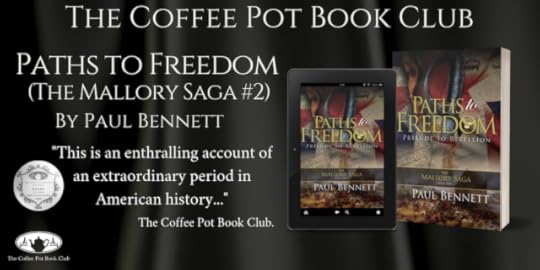
Paths to Freedom (The Mallory Saga #2)By Paul Bennett
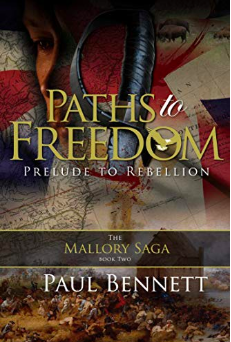
The French and Indian War is over, but the aftermath widens the gulf between the colonies and King George III. A hard handed approach by the King and Parliament fuels the flames of resistance; flames that soon engulf the Mallory clan, consuming the frontier, shattering their hopes for Mallory Town, and changing their lives forever. Revolution is nigh.
The Coffee Pot Book Club
★★★★★
Highly Recommended
Read the full review HERE!
Pick up your copy ofPaths to FreedomAmazon UK • Amazon US
Paul Bennett
 Paul’s education was of the public variety and when he reached Junior High he discovered that his future did not include the fields of mathematics or science. This was generally the case throughout his years in school as he focused more on his interest in history; not just the rote version of names and dates but the causes. Paul studied Classical Civilization at Wayne State University with a smattering of Physical Anthropology thrown in for good measure. Logically, of course, Paul spent the next four decades drawing upon that vast store of knowledge working in large, multi-platform data centers, and is considered in the industry as a bona fide IBM Mainframe dinosaur heading for extinction. Paul currently resides in the quaint New England town of Salem, Massachusetts with his wife, Daryl. The three children have all grown, in the process turning Paul’s beard gray, and have now provided four grandchildren; the author is now going bald.
Paul’s education was of the public variety and when he reached Junior High he discovered that his future did not include the fields of mathematics or science. This was generally the case throughout his years in school as he focused more on his interest in history; not just the rote version of names and dates but the causes. Paul studied Classical Civilization at Wayne State University with a smattering of Physical Anthropology thrown in for good measure. Logically, of course, Paul spent the next four decades drawing upon that vast store of knowledge working in large, multi-platform data centers, and is considered in the industry as a bona fide IBM Mainframe dinosaur heading for extinction. Paul currently resides in the quaint New England town of Salem, Massachusetts with his wife, Daryl. The three children have all grown, in the process turning Paul’s beard gray, and have now provided four grandchildren; the author is now going bald.For more information, please visit the Mallory Saga Facebook page. You can also find Paul on his Blog, Twitter, and Goodreads.
Published on April 30, 2020 20:00
Upcoming Blog Tour: The Road to Liberation: Trials and Triumphs of WWII May 5th — May 14th 2020 #HistoricalFiction #WWII #CoffeePotBookClub

The Road to Liberation: Trials and Triumphs of WWIIA CollectionBy Marion Kummerow, Marina Osipova, Rachel Wesson, JJ Toner, Ellie Midwood, and Chrystyna Lucyk-Berger.
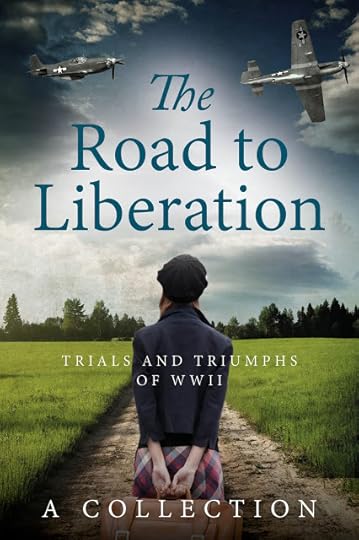
Riveting stories dedicated to celebrating the end of WWII.
From USA Today, international bestselling and award-winning authors comes a collection filled with courage, betrayal, hardships and, ultimately, victory over some of the most oppressive rulers the world has ever encountered.
By 1944, the Axis powers are fiercely holding on to their quickly shrinking territories.
The stakes are high—on both sides:
Liberators and oppressors face off in the final battles between good and evil. Only personal bravery and self-sacrifice will tip the scales when the world needs it most.
Read about the heroic act of a long-term prisoner, an RAF squadron leader on the run in France, a small child finding unexpected friends amidst the cruelty of the concentration camps, a shipwrecked woman captured by the enemy, and a young Jewish girl in a desperate plan to escape the Gestapo.2020 marks 75 years since the world celebrated the end of WWII. These books will transport you across countries and continents during the final days, revealing the high price of freedom—and why it is still so necessary to “never forget”.
Stolen Childhood by Marion KummerowThe Aftermath by Ellie MidwoodWhen's Mummy coming? by Rachel WessonToo Many Wolves in the Local Woods by Marina OsipovaLiberation Berlin by JJ TonerMagda’s Mark by Chrystyna Lucyk-Berger
Pick up your copy of
The Road to Liberation: Trials and Triumphs of WWII
Amazon US • Amazon UK • Amazon CA
Marion Kummerow
Marion Kummerow was born and raised in Germany, before she set out to "discover the world" and lived in various countries. In 1999 she returned to Germany and settled down in Munich where she's now living with her family.
After dipping her toes with non-fiction books, she finally tackled the project dear to her heart. UNRELENTING is the story about her grandparents, who belonged to the German resistance and fought against the Nazi regime. It's a book about resilience, love and the courage to stand up and do the right thing.
Marina Osipova
Marina Osipova was born in East Germany into a military family and grew up in Russia where she graduated from the Moscow State Institute of History and Archives. She also has a diploma as a German language translator from the Moscow State Institute of Foreign Languages. In Russia, she worked first in a scientific-technical institute as a translator then in a Government Ministry in the office of international relations, later for some Austrian firms. For seventeen years, she lived in the United States where she worked in a law firm. Eventually, she found her home in Austria. She is an award-winning author and a member of the Historical Novel Society.
Rachel Wesson
Rachel Wesson is Irish born and bred. Drawn to reading from an early age, she started writing for publication a few years back. When she is not writing, Rachel likes to spend her time reading and playing with her three kids. Living in Dublin there are plenty of things to do, although the cowboys and Indians of her books rarely make an appearance. To chat with Rachel connect with her on Facebook - authorrachelwesson. To check out her newest releases sign up to her mailing list.
JJ Toner:
My background is in Mathematics and computing, but I have been writing full time since 2005. I write short stories and novels. My novels include the bestselling WW2 spy story 'The Black Orchestra', and its three sequels, 'The Wings of the Eagle', 'A Postcard from Hamburg', and 'The Gingerbread Spy'.
Many of my short stories have been published in mainstream magazines. Check out 'EGGS and Other Stories' - a collection of satirical SF stories. I was born in a cabbage patch in Ireland, and I still live here with my first wife, although a significant part of our extended family lives in Australia.
Ellie Midwood
Ellie Midwood is a USA Today bestselling and award-winning historical fiction author. She owes her interest in the history of the Second World War to her grandfather, Junior Sergeant in the 2nd Guards Tank Army of the First Belorussian Front, who began telling her about his experiences on the frontline when she was a young girl. Growing up, her interest in history only deepened and transformed from reading about the war to writing about it. After obtaining her BA in Linguistics, Ellie decided to make writing her full-time career and began working on her first full-length historical novel, "The Girl from Berlin." Ellie is continuously enriching her library with new research material and feeds her passion for WWII and Holocaust history by collecting rare memorabilia and documents.
In her free time, Ellie is a health-obsessed yoga enthusiast, neat freak, adventurer, Nazi Germany history expert, polyglot, philosopher, a proud Jew, and a doggie mama. Ellie lives in New York with her fiancé and their Chihuahua named Shark Bait.
Chrystyna Lucyk-Berger
Chrystyna Lucyk-Berger was born in Minnesota in 1969 and grew up in the culture-rich neighborhood of "Nordeast" Minneapolis. She started her writing career with short stories, travel narratives, worked as a journalist and then as a managing editor for a magazine publisher before jumping the editor's desk and pursuing her dreams of writing and traveling. In 2000, she moved to western Austria and established her own communications training company. In 2005, she self-published a historical narrative based on her relatives' personal histories and experiences in Ukraine during WWII. She has won several awards for her short stories and now primarily writes historical fiction. During a trip into northern Italy over the Reschen Pass, she stood on the edge of Reschen Lake and desperately wanted to understand how a 15th-century church tower ends up sticking out of the water. What stories were lying beneath? Some eight years later, she launched the "Reschen Valley" series with five books and a novella releasing between 2018 and 2021.
For more on Chrystyna, dive in at inktreks(dot)com.
Published on April 30, 2020 02:32
April 29, 2020
Join #HistoricalFiction author, Mary Ann Bernal, as she takes a look back in time to the plight of the Lepers. There is also a chance to check out Mary Ann’s fabulous new book — Crusader’s Path #History @BritonandDane
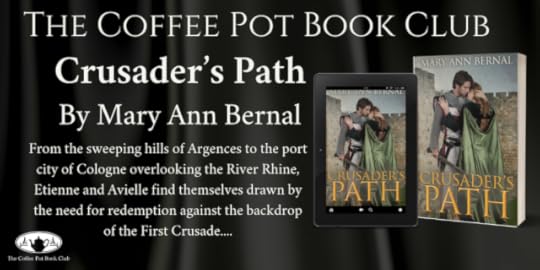
The Plight of the LepersMary Ann Bernal
Leprosy (Hansen’s Disease) has been around long before 1550 B.C. when the infection was first documented in ancient Egypt and other countries. The culprit behind the now-treatable disorder is Mycobacterium leprae, a bacterium related to the tuberculosis strain.
Recapping some of the symptoms include disfigurement, claw hands, skin lesions, nerve damage, muscle weakness, and a collapsed nose. The contagion is spread through skin contact and respiratory secretions. While leprosy is contagious, it never reached pandemic proportions. Meaning, isolating the poor souls was never necessary, so much heartbreak because of ignorance.
Leviticus 14 provides a recipe for a “cure” where bird blood is sprinkled over the affected person. Throughout the ages, dog and lamb blood was used to either drink or bathe in. Desperation leads to desperate measures as witnessed by the various odd treatments using snake venom, frog poison, bee and scorpion stings, and chaulmoogra oil to apply on the lesions. Worse yet was the use of arsenic and castration, believing the disease was sexually transmitted.
Fear and superstition held a firm grip on societal mores. Why were lepers shunned? Was it because of Leviticus? Was it not written the afflicted were unclean? And of course, the inference for causation was sin. Even though the New Testament states, Jesus healed lepers while forgiving sins, mankind was not as forgiving.
 Leprosy victims taught by bishop — Wikipedia.
Leprosy victims taught by bishop — Wikipedia.Leviticus states lepers are unclean and sinful. The afflicted were shunned, forced to live in caves during Biblical times, and in colonies as the centuries passed. Laws were enacted to protect the population. Lepers lost their rights. They were declared legally dead, forced to participate in a ritual where they stood in an open grave as the damming words were read. They became the living dead. Their property was confiscated; all their wealth went into governmental coffers. They were denied entry to places inhabited by healthy people.
Leper houses and asylums became prominent throughout all of Christendom in the Middle Ages. If not confined, the lepers had to follow harsh rules. They had to wear special clothing and play a wooden clapper, later a bell, to warn of their approach. They also had to take vows listed in the Mass of Separation. And yes, rich lepers fared better than poor ones.
It is hard to visualize a beloved family member being treated with disdain, ostracized by the community, and forced to live a life of misery, begging for alms, bereft of hope. Can you imagine yourself having to ring a bell as you approached the local mall, warning people of your imminent arrival? You probably wouldn’t have made it out of the parking lot before the Police arrived.
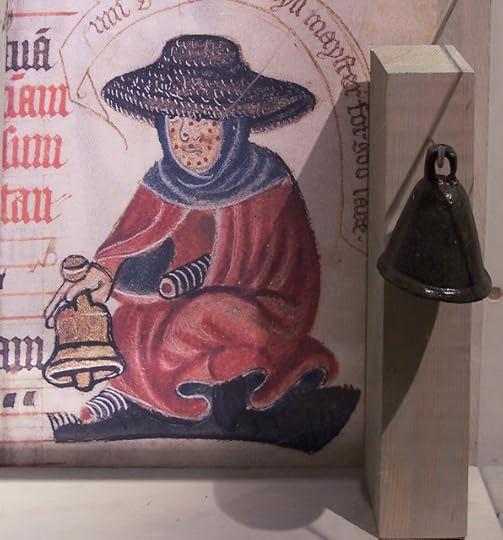 Medieval leper bell at the museum Ribes Vikinger, Ribe, Denmark — Wikipedia.
Medieval leper bell at the museum Ribes Vikinger, Ribe, Denmark — Wikipedia.Grant it, catching a disease was very scary throughout time. We still shy away from people infected with some respiratory disease, sending sick workers home. How many times have you heard “I’m not contagious” when greeting someone who has a runny nose and coughs a lot? And remember how patients with AIDS were treated when the disease was first diagnosed? Fear and ignorance reigned, just like it did when lepers walked the countryside in days of old. At least, today, we are fortunate to have science to explain the unexplainable. We have the Centers for Disease Control and Prevention (CDC). While we are much better off than our forebearers, we still have a long way to go to eradicate the fear and educate the ignorant.
Hawaii’s leper colony is located at Kalaupapa, on the island of Molokai. It housed thousands of infected people since its inception in 1866. The statement by Makia Malo is a stark reminder of society’s failure to embrace the truth.
 Kalaupapa leper colony in 1905 Wikipedia.
Kalaupapa leper colony in 1905 Wikipedia.In 2003, patient Makia Malo said to the Associated Press, “One of the worst things about having had this disease is that even after you're cured, society will not let you heal because of the 'L' word. People don't know how hurtful and wrong that term is.”
The word leper is synonymous with outcast and is offensive to modern-day sufferers of the disease. While using the medical term, Hansen’s disease, is preferable, an acceptable alternative is stating the person has leprosy.
Leprosy is a curable disease today, but there are still people being crippled by this wretched pestilence. India, Brazil, and Indonesia have the highest rate of infection.
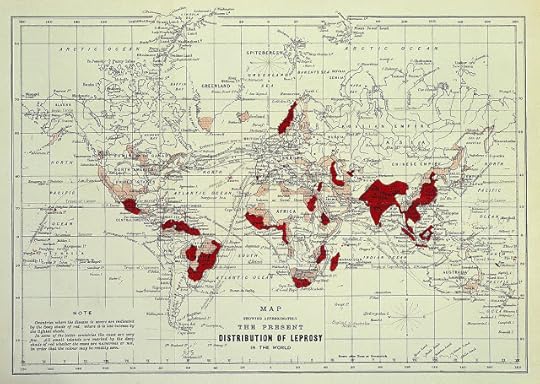 Distribution of leprosy around the world Wellcome— Wikipedia.
Distribution of leprosy around the world Wellcome— Wikipedia.World Leprosy Day is observed on the last Sunday in January.
Crusader’s PathBy Mary Ann Bernal

From the sweeping hills of Argences to the port city of Cologne overlooking the River Rhine, Etienne and Avielle find themselves drawn by the need for redemption against the backdrop of the First Crusade.
Heeding the call of His Holiness, Urban II, to free the Holy Land from the infidel, Etienne follows Duke Robert of Normandy across the treacherous miles, braving sweltering heat and snow-covered mountain passes while en route to the Byzantine Empire.
Moved by Peter of Amiens’ charismatic rhetoric in the streets of the Holy Roman Empire, Avielle joins the humble army of pilgrims. Upon arrival in Mentz, the peasant Crusaders do the unthinkable, destroying the Jewish Community. Consumed with guilt, Avielle is determined to die fighting for Christ, assuring her place in Heaven.
Etienne and Avielle cross paths in Constantinople, where they commiserate over past misdeeds. A spark becomes a flame, but when Avielle contracts leprosy, Etienne makes a promise to God, offering to take the priest cowl in exchange for ridding Avielle of her affliction.
Will Etienne be true to his word if Avielle is cleansed of the contagion, or will he risk eternal damnation to be with the woman he loves?
Pick up your copy ofCrusader’s PathAmazon
Mary Anne Bernal
 Mary Ann Bernal attended Mercy College, Dobbs Ferry, NY, where she received a degree in Business Administration. Her literary aspirations were ultimately realized when the first book of The Briton and the Dane novels was published in 2009. In addition to writing historical fiction, Mary Ann has also authored a collection of contemporary short stories in the Scribbler Tales series. Her latest endeavor is a science fiction/fantasy novel entitled Planetary Wars Rise of an Empire. Originally hailing from New York, Mary Ann now resides in Elkhorn, Nebraska.
Mary Ann Bernal attended Mercy College, Dobbs Ferry, NY, where she received a degree in Business Administration. Her literary aspirations were ultimately realized when the first book of The Briton and the Dane novels was published in 2009. In addition to writing historical fiction, Mary Ann has also authored a collection of contemporary short stories in the Scribbler Tales series. Her latest endeavor is a science fiction/fantasy novel entitled Planetary Wars Rise of an Empire. Originally hailing from New York, Mary Ann now resides in Elkhorn, Nebraska.Connect with Mary Ann: Website • Whispering Legends Press • Twitter.
Published on April 29, 2020 20:00
April 28, 2020
#BookReview — There is Always a Tomorrow (The Graham Saga, Book #9) by Anna Belfrage #HistoricalFiction #TimeTravel @abelfrageauthor
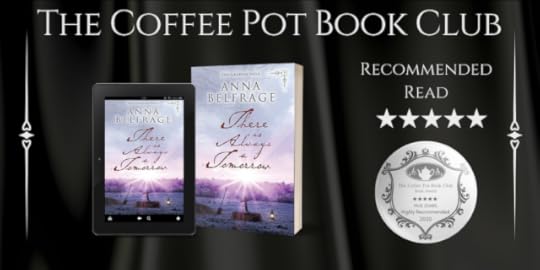
There is Always a Tomorrow(The Graham Saga, Book #9)By Anna Belfrage
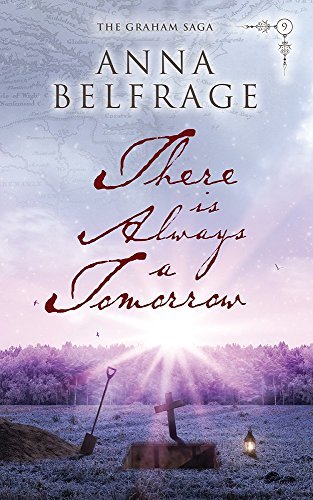
It is 1692 and the Colony of Maryland is still adapting to the consequences of Coode’s Rebellion some years previously. Religious tolerance in the colony is now a thing of the past, but safe in their home, Alex and Matthew Graham have no reason to suspect they will become embroiled in the ongoing religious conflicts—until one of their sons betrays their friend Carlos Muñoz to the authorities.
Matthew Graham does not leave his friends to rot—not even if they’re papist priests—so soon enough most of the Graham family is involved in a rescue attempt, desperate to save Carlos from a sentence that may well kill him.
Meanwhile, in London little Rachel is going through hell. In a matter of months she loses everything, even her surname, as apparently her father is not Master Cooke but one Jacob Graham. Not that her paternity matters when her entire life implodes.
Will Alex and Matthew be able to help their unknown grandchild? More importantly, will Rachel want their help?

“I did as I had to do,” Daniel said, straightening up to his full, rather impressive, height. The only one of their sons who overtopped his father by an inch or so, Daniel Graham was a good-looking man, bright blue eyes contrasting with his dark hair.
“I guess that’s what Pilate said as well,” Alex retorted.
Matthew Graham had sent his son away to learn to be a man of God, but he would never have thought that the same son would be instrumental in another man’s suffering — a friend’s suffering.
Like Jesus, Carlos Muñoz prayed for a merciful death, but with a corrupt magistrate proceeding over the trial, Carlos fears for the worst. The only way he can survive such torment is if his friends take the law into their own hands…
From a desperate rescue to save a man’s life to the longed-for homecoming of a prodigal son, There is Always a Tomorrow (The Graham Saga, Book #9) by Anna Belfrage is the dramatic conclusion of a story of one woman who fell through time and found herself in the 17th Century.
I have been enchanted with The Graham Saga from the opening chapter of A Rip in the Veil (The Graham Saga, Book #1) to the end of that very final full stop in There is Always a Tomorrow (The Graham Saga, Book #9). Absorbing, heart-warming and utterly captivating, Belfrage has captured the very essence of this period — from the evocative depiction of Scotland, the bustling back-alleys of London, the seemingly tranquil streets of Seville, Spain, the horrors of slavery in the West Indies, to the majestically beautiful Colony of Maryland. With such a large and wonderful canvas, which history tells us was ripe with volatile political instability and religious ideology, Belfrage has crafted a series that is as absorbing as it is compelling. This is a series that bewitches, and as it is a time-travel adventure there really is something for everyone. It is a series bursting with swoon-worthy romance, war, religious persecution, witch trials, hate, love, survival, and on top of this it is also a sprawling family sage that entwines two very different centuries over three very turbulent decades.
I was both looking forward to and dreading reading There is Always a Tomorrow (The Graham Saga, Book #9). I was looking forward to it because I have cherished every book in this series, and I could not wait to find out what would happen next. I was dreading it because book #9 is the very last book, and I did not want this story to end. I held my breath with trepidation as I picked up this novel and allowed myself to be swept back to the 17th century. There is Always a Tomorrow is perhaps the darkest book in The Graham Saga. There are scenes in this story that are incredibly distressing. One of the characters endures the most horrific abuse, and the consequences of such abuse are dreadful for everyone who tries to help the abused. There are also moments of intolerance, cruelty and revenge. Belfrage reminds us that to glorify the past is to give a false sense of time and place. This was a brutally unforgiving era, and life was hard. It is a very sobering account of what life was like in the 17th century. But, it is also a story of hope, putting aside past grievances and coming together for the greater good. This is a story about one family and their tenacious determination to stay together even if they are spread out all over the world.
What a journey the protagonists have taken us on. Alex and Matthew Graham — a love story centuries in the making. The trials and tribulations these two beloved characters have to go through had me reaching for the tissues on more than one occasion. This time I came prepared with a box of tissues close at hand before I even started reading! It was a wise decision. With old age creeping rapidly upon them, Alex and Matthew have seen it all. They have buried loved ones. They have watched the world around them change and develop, not always for the better. Alex, having travelled through time, also has the terrible burden of hindsight, which at times is heart-rendering. I adored Alex from the moment she was first introduced. She is this strong, feisty woman, but she also has this overflowing ability to love, and it is her love that binds her family together. It was an absolute pleasure spending so many hours in her company. Matthew, on the other hand... I will admit, at times he was infuriating, especially in the early years of their marriage, but he is also devoted to Alex and his family. He is a man with a time-travelling wife whose ideas and theories, backed up by science, are so different from his god-fearing upbringing. Matthew is a character whom I grew to love. His depiction was fabulously drawn, and his devotion to his wife and his strength of character brings so much to this tale. Bravo, Ms Belfrage.
This is the novel where I found myself rather disconcertingly thinking “Go, Luke” — the antagonist became a protagonist, I never saw that coming! Luke is a character that I despised right up until Book #8 when he began to try and make amends for the damage and heartache he has caused. He is still not the kind of person you want as an enemy, but old age has given him a certain amount of wisdom, and he is very protective of those whom he loves. In this novel, Luke becomes someone who you would perhaps now acknowledged if you were to meet him in the street, rather than crossing the road and hoping he did not notice you! I thought Belfrage’s depiction of Luke throughout this series was superb. He is a villain, a murderer, but he is also compassionate and fiercely loyal. An anti-hero who one really should hate, but I just could not find it in myself to hate this character anymore. Dare I say, by the end of this novel, I almost liked him.
The Grahams are an extensive extended family, and each character has had a part to play in this tale. Characters such as Ian captured my heart when they were first introduced, and others, like Michael Conner and Julian Allerton, became characters whom I grew to respect. But of all the secondary characters in this series, it is Matthew and Alex’s son, Samuel, “White Bear” who I loved the most. Samuel is one of the most conflicted characters in this series, more so even than his time-travelling half-brother, Isaac, who at least knew where he wanted to be. Caught between his adoptive Indian family and his parents, Samuel struggles to find a place for himself in two vastly different worlds. His choices have terrible consequences for his family, and he so desperately wants to please everyone but, in the end, he realises that such a thing is impossible. Samuel sealed the deal on this series for me, and he really comes into his own in this book. I thought his depiction was truly amazing, and he is a character that would be impossible to forget.
It was with a strange sense of heartache that I found myself turning the last page, but then I realised that this was not where the story ended, it was where the book did, and in my mind, I can still see all of these characters going about their everyday lives. And as the years go by and generation after generation of the Grahams live and die, one cannot help but wonder about that muggy August day in three hundred years time, when the past and future will collide, and Alex Lind will be once again thrown through a rip in the veil.
I Highly Recommend.
Review by Mary Anne Yarde.The Coffee Pot Book Club.
Pick up your copy ofThere is Always a TomorrowAmazon UK • Amazon US
Anna Belfrage
 Had Anna been allowed to choose, she’d have become a time-traveller. As this was impossible, she became a financial professional with two absorbing interests: history and writing. Anna has authored the acclaimed time travelling series The Graham Saga, set in 17th century Scotland and Maryland, as well as the equally acclaimed medieval series The King’s Greatest Enemy which is set in 14th century England. She has recently released the first in a new series, The Wanderer. This time, she steps out of her normal historical context and A Torch in His Heart is with a fast-paced contemporary romantic suspense with paranormal and time-slip ingredients.
Had Anna been allowed to choose, she’d have become a time-traveller. As this was impossible, she became a financial professional with two absorbing interests: history and writing. Anna has authored the acclaimed time travelling series The Graham Saga, set in 17th century Scotland and Maryland, as well as the equally acclaimed medieval series The King’s Greatest Enemy which is set in 14th century England. She has recently released the first in a new series, The Wanderer. This time, she steps out of her normal historical context and A Torch in His Heart is with a fast-paced contemporary romantic suspense with paranormal and time-slip ingredients.Find out more about Anna by visiting her website, or her Amazon page.
Published on April 28, 2020 20:00
April 27, 2020
Book Review — We All Fall Down Stories of Plague and Resilience #Anthology #HistoricalFiction @swiftstory @Krisgleeson @lisajyarde @lauramorelliphd @David_Blixt @writerjeangill. @melodiewinawer
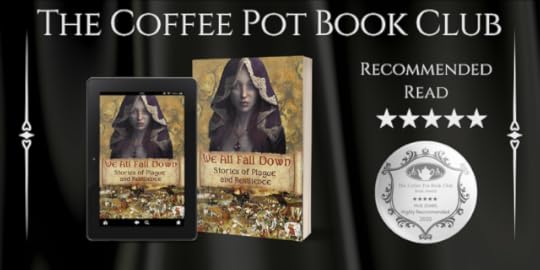
We All Fall DownStories of Plague and ResilienceBy Kristin Gleeson,Lisa J. Yarde, Laura Morelli, J. K. Knauss, David Blixt, Jean Gill, Deborah Swift, Katherine Pym, Melodie Winawer
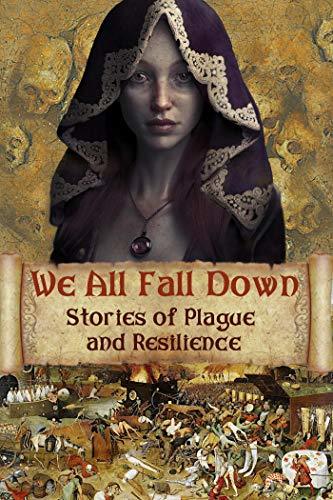
Plague has no favorites.
In this anthology, USA Today, international bestselling, and award-winning authors imagine a world where anyone—rich, poor, young, old—might be well in the morning and dead by sundown.
Readers will follow in the footsteps of those who fought to rebuild shattered lives as the plague left desolation in its wake.
* An Irish woman tends her dying father while the Normans threaten her life and property—
* A Hispano-Muslim doctor fights the authorities to stem the spread of the deadly pestilence at great personal cost—
* A Tuscan street hawker and a fresco painter watch citizens perish all around them even as they paint a better future—
* A Spanish noblewoman lives at the mercy of a jealous queen after plague kills the king—
* The Black Death leaves an uncertain legacy to Dante’s son—
* In Venice, the artist Titian agonizes over a death in obscurity—
* A Scottish thief loses everything to plague and repents in the hope of preventing more losses—
* Two teenagers from 2020 time-travel to plague-stricken London and are forever changed—
* And when death rules in Ottoman-occupied Greece, a Turk decides his own fate.
Nine tales bound together by humanity’s fortitude in the face of despair: a powerful collection of stories for our own time.
In dark and deadly times, love and courage shine bright.

“In my youth, I imagined what Death was like. I tried to picture my own death. I remember hoping for a “good” death. As if there could be such a thing.”
"On All Our Houses" by David Blixt
It was a pestilence, an epidemic, a plague. History would remember it as den sorte død — The Black Death. But while those who survived tried to rebuild their lives, this was not the end. For the plague would come again and it would take more sons, daughters, fathers, mothers, and it would change the course of history forever…
We All Fall Down - Stories of Plague and Resilience by Kristin Gleeson, Lisa J. Yarde, Laura Morelli, J. K. Knauss, David Blixt, Jean Gill, Deborah Swift, Katherine Pym, Melodie Winawer is a collection of short stories that explores what life was like when The Black Death came calling.
Told with an enthralling sense of time and place, We All Fall Down - Stories of Plague and Resilience is a fascinating, if somewhat harrowing story, of nine very different people as the plague touches their lives with devastating consequences. From pauper to king, the plague did not differentiate. It struck without warning and killed, sometimes in hours. This is a novel which will resonate very much with today’s readers.
The short-stories in this book are richly detailed and emotionally charged, which left me reaching for the tissues on more than one occasion. The compelling narrative that captured the despair, the fear and the heartache, evoked a world where diseases were not understood, and the cures were often more brutal than the illness itself. The complete lack of understanding of the plague and the almost cavalier attitude that the economy and trade was more important than saving lives is played out with all of its greed. While the rich hid behind their high walls, the rest of the population was left to fend for itself. It is a stark reminder of how fragile life is and how money does not ensure immunity.
Kristin Gleeson takes her readers on a journey to Clyde in the middle of the 14th Century. This incredible story, set within the backdrop of the plague, demonstrates the evils of man as one individual tries to use the plague as a way to increase his own profits. “The Blood of the Gaels” is a story that I really enjoyed. Not only is it a story of death and disaster, but it is also one of love and hope. It was a fabulous book to open this anthology with.
We travel back in time to 17th Granada in Lisa J. Yarde’s “The Heretic”. Ibn al-Khatib dared to explore theories about how the disease was transmitted and much to the abhorrence of everyone else, how to contain it. This book gives the readers an intimate insight into the suffering and loss that Ibn al-Khatib suffered during this tragic period of history. I thought this book was exceptionally well written and incredibly insightful into the period and the man.
"Little Bird" by Laura Morelli was a wonderful story about a young girl who travels across medieval Tuscany with a band of cure sellers! I loved this story so much. Morelli gives her readers an intimate insight into the life of a travelling tradesman. The lengths they will go to, to sale their wares, were really quite extraordinary. Ironically, these so-called healers helped to spread this terrible disease. I thought Little Bird was fabulous from start to finish, and I could have easily read a full-length novel about this young girl’s adventures.
J. K. Knauss' lavish attention to the historical detail in her fabulous story "Footsteps" has to be commended. Oh, how I loved this story. Knauss' depiction of Leonor Núñez de Guzmán y Ponce de León was sublime. This is a story that captured the essence of the era. Wonderful, wonderful storytelling.
We travel next to Gargagnago, Italy, where a father is contemplating life as his daughter's body is ravished with the plague. "On All Our Houses" by David Blixt is a heartbreakingly tender story of a man who has to watch the people he loves succumb to the plague while he, for some reason, does not. This is a story that really draws the reader in and does not let go until that final full stop.
Told from Deaths point of view "A Certain Shade of Red" by Jean Gill sent shivers down my spine. Portraying the final hours of Renaissance artist Tiziano “Titian,” Vecell, Gill has penned an utterly enthralling story. This story really captured my imagination and I loved every second of it. My only complaint was that it was much too short!
My favourite story in this anthology was "The Repentant Thief" by Deborah Swift. Swift sweeps her readers back to 17th Century Edinburgh where the authorities try to contain the plague by moving the inflicted and those who had been in contact with the disease into makeshift camps. This story is a tear-jerking tale about a young boy who thinks he has brought the plague down upon his family because he stole a necklace. The horrific conditions of the camp and the swiftness of the disease are portrayed in all of its horrifying detail. This is a story that will stay with me for a long time.
Taking a slightly different approach, Katherine Pym has presented her readers with a time-travelling tale in "Arrows that Fly in the Dark." The two young protagonists fall through time to plague-ridden London. With modern-day knowledge, the protagonists can only watch and observe as the doctor tends his patients. I think this would be the last place any time-traveller would want to end up and I thought this story was really refreshing and exceptionally real in the telling. Being thrown into an era where medical advances were slow and basic hygiene was not observed is a terrible thing to witness. Kudos Ms Pym for thinking outside of the box.
We are heading to 17th century Greece in the last short-story in this anthology. "778" by Melodie Winawer was enchanting from start to finish and one I simply could not put down. From the meticulously researched history to the sumptuously addictive narrative, this is the kind of story that threatens to mesmerise.
We All Fall Down - Stories of Plague and Resilience is an ambitious but very successful anthology. The topic may be dark, but the stories are marvellous. And the stories are short enough to be enjoyed over a quick coffee break.
I Highly Recommend.
Review by Mary Anne Yarde.The Coffee Pot Book Club.
Pick up your copy of We All Fall Down Amazon UK • Amazon US
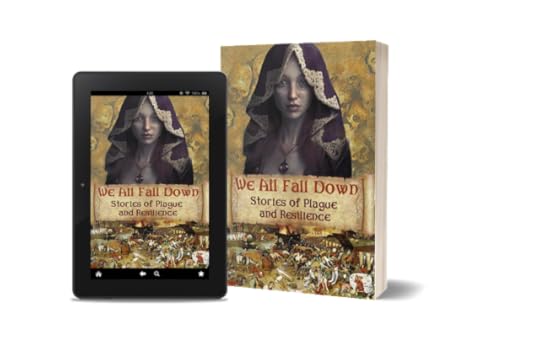
Published on April 27, 2020 20:30
#BookReview — How to Catch an Errant Earl (The Disreputable Debutantes #2) by Amy Rose Bennett #RegencyRomance #NewRelease @AmyRoseBennett
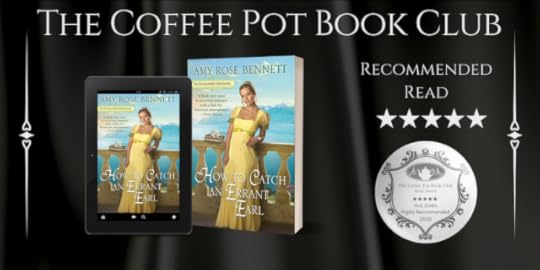
How to Catch an Errant Earl(The Disreputable Debutantes #2)By Amy Rose Bennett
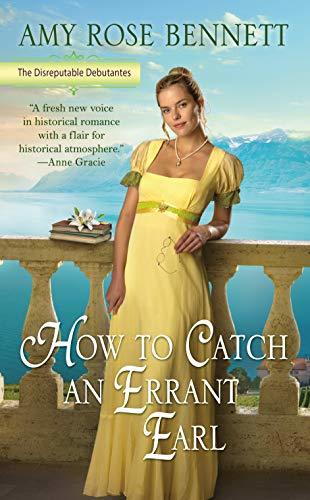
A debutante with a scandalous past is whisked away from London only to create new headlines on the Continent.
After being expelled from a young ladies’ academy, it seems Miss Arabella Jardine will never find a well-connected husband. Not that she minds. A bluestocking at heart, she’d rather bury her nose in a medical text than wed. When Arabella is forced to accompany her family on a Grand Tour in Switzerland, she unexpectedly encounters the irresistible rakehell-in-exile, Gabriel, the Earl of Langdale. Arabella soon realizes the only thing worse than getting married to a charismatic but unrepentant rake would be to fall in love with him.
Dubbed the Errant Earl by the ton, Gabriel Holmes-Fitzgerald is no stranger to scandal. However, when Gabriel is caught in flagrante with the utterly delectable Arabella Jardine, he’s obliged to offer for her hand. He’ll endeavor to do the right thing even though he’s not a prize catch. He’ll certainly never let Arabella get close enough to discover the demons of his dark past. Indeed, there is one particular demon out to destroy Gabriel by exposing a long-buried family secret.
Soon Gabriel and Arabella find they are not just battling overwhelming desire, but in a fight to save their future together.

"I must warn you, Miss Jardine," he said in a voice that was almost a purr. "I'm a man prone to acting on impulse, and I'm sorely tempted to kiss you right now…"
Arabella really shouldn't. Gabriel Holmes-Fitzgerald, Earl of Langdale, is a notorious rake. But the way he was looking at her — no one had ever looked at her that way before. And it was not as if her reputation was as spotless as newly fallen snow, she had, after all, been expelled from Mrs. Rathbone's Academy three years previous, and it wasn't as if the Earl of Langdale was Lord Byron. It would just be one little kiss, and no one would know. It would be their secret, forever…
From a chance meeting in the dungeons of Château de Chillon to the proclamation of true love, How to Catch an Errant Earl (The Disreputable Debutantes #2) by Amy Rose Bennett is the emotionally charged story of two very lonely souls discovering love when they least expected it.
One of my favourite Regency Romance authors is back with another passionate tale of love, heartache, danger, romance, and desire. Bennett is an author that keeps on giving. Her stories are always richly detailed with dashing heroes that a reader can fall in love with, and feisty heroines that one cannot help but admire. How to Catch an Errant Earl is everything I expected it to be, and then some.
With an enthrallingly sensual narrative, and a story that is as impressive in its sweep as in its brilliance, How to Catch an Errant Earl has a lot to recommend it. This book swept me away with its emotional love scenes, and its message that love, with the right person, is enduring, and happy endings can and do happen.
Miss Arabella Jardine is a young woman who is forced to hide her dreams. Her willful and spirited personality is tempered by her demanding and insulting aunt, who despises her. Arabella's treatment by her family is beyond cruel, and how she puts up with her vile aunt without losing her temper is a mystery. However, despite her past and current situation, Arabella is a compassionate and caring woman who is passionate about improving the conditions of orphaned and abandoned children. She is determined to help in any way she can. Her interest and understanding of medicine, thanks to her grandfather, also does not help with her domestic situation, for such interests are unseemly. It isn't until Arabella meets Gabriel that she begins to think about her own wants. I adored Arabella. She is intelligent, quick to smile, more than a match for Gabriel, and she is also this wonderful, passionate woman who isn't afraid to speak her mind, except when she is in her aunt's company — then she behaves submissively, but then you would when such abuse is unrelenting. Her depiction is superb. Kudos Ms Bennett.
Gabriel is a dashing rogue, who leaves a trail of broken hearts behind him. Women fall over themselves to be with him, and I can see why. Bennett has certainly depicted a swoon-worthy hero. However, Arabella is not like the other women he has been in a relationship with before. He is drawn towards her like a moth is to a flame. He initially passes it off as lust, having never been in love. However, he soon discovers that what he feels isn't just lust because he wants to know her — her thoughts, her feelings, what she likes, what she doesn’t. He cares about what happens to her. Gabriel’s life, despite his wealth and position, is not what it appears. A scandal, and not just because of his many passionate liaisons, threatens to destroy his reputation beyond salvation. He is unfailingly honest with Arabella about what the consequences could mean for her, and I think that is one of the reasons why I liked him so much. He is a rake, but he is an honest one. Gabriel is in all ways a contradiction. He never promises his lovers anything, until he meets Arabella, and then his promises take a significance that will change the course of his life. Bennett has portrayed a man who is scared of commitment, who is terrified that if he should love, then it will be thrown back in his face. His backstory is utterly heartrending, and it goes some way to explain why he does what he does. I thought his depiction was absolutely fabulous. Gabriel really drove this story forward, and I so enjoyed reading about him.
Bennett evokes a strong sense of time and place in this novel. The depiction of the Château de Chillon was sublime, and one could understand through Bennett's portrayal why the castle attracted so many romance writers in the 19th century, including, of course, the notorious Lord Byron!
There was nothing about this book I did not love. I was enchanted from the opening sentence to the last full stop. How to Catch an Errant Earl (The Disreputable Debutantes #2) by Amy Rose Bennett is a beautiful Regency Romance, and it is a book that I could happily read over and over again.
I Highly Recommend.
Review by Mary Anne Yarde.The Coffee Pot Book Club.
Pick up your copy ofHow to Catch an Errant EarlAmazon UK • Amazon US
Amy Rose Bennett
 Amy Rose Bennett is an Australian author who has a passion for penning emotion-packed historical romances. Of course, her strong-willed heroines and rakish heroes always find their happily ever after.
Amy Rose Bennett is an Australian author who has a passion for penning emotion-packed historical romances. Of course, her strong-willed heroines and rakish heroes always find their happily ever after.A former speech pathologist, Amy is happily married to her very own romantic hero and has two lovely, very accomplished adult daughters. When she’s not creating stories, Amy loves to cook up a storm in the kitchen, lose herself in a good book or a witty rom-com, and when she can afford it, travel to all the places she writes about.
Connect with Amy Rose: Website • Facebook • Twitter • Bookbub • Pinterest • Amazon
Published on April 27, 2020 20:00
The Coffee Pot Book Club
The Coffee Pot Book Club (formally Myths, Legends, Books, and Coffee Pots) was founded in 2015. Our goal was to create a platform that would help Historical Fiction, Historical Romance and Historical
The Coffee Pot Book Club (formally Myths, Legends, Books, and Coffee Pots) was founded in 2015. Our goal was to create a platform that would help Historical Fiction, Historical Romance and Historical Fantasy authors promote their books and find that sometimes elusive audience. The Coffee Pot Book Club soon became the place for readers to meet new authors (both traditionally published and independently) and discover their fabulous books.
...more
...more
- Mary Anne Yarde's profile
- 159 followers



